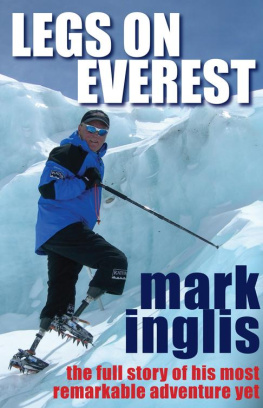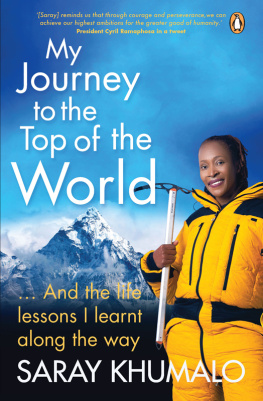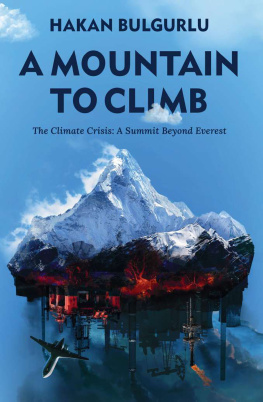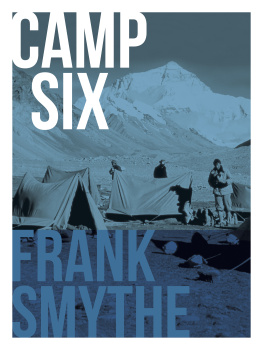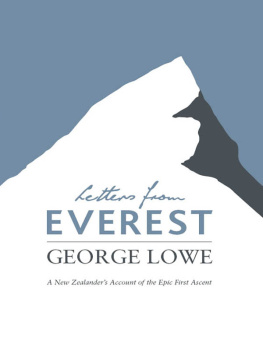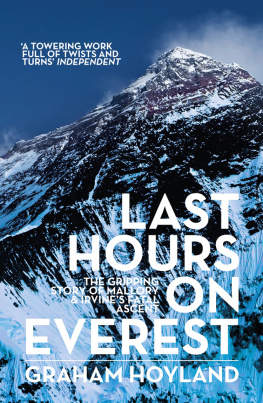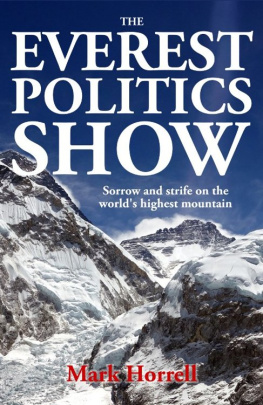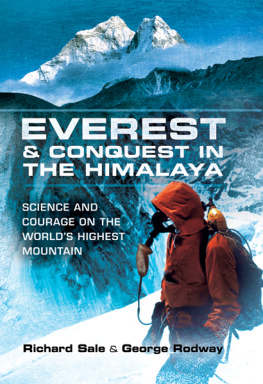On 15 May 2006 double amputee Mark Inglis fulfilled a childhood ambition: to stand on the summit of the highest mountain in the world. Legs on Everest follows Marks preparation for the Everest attempt, including climbing Cho Oyu in the Himalayas, and the build-up to the summit push. It shows that reaching the top of Everest is only half the journey you have to get back down alive.
Here at last is the full story of Marks Everest expedition a story of determination, pain, controversy and overcoming seemingly impossible obstacles, both physical and psychological. It s full of gripping detail, providing a fascinating insight into the world of extreme mountaineering straight from the heart of one of New Zealand s most incredible personalities. It s also humorous, deeply moving, enlightening and entertaining.
and a taste of things to come
3am, 7 January 2002
Linda Glacier, Aoraki/Mount Cook, New Zealand
Its been 20 years since I last spent a night on this mountain. Back then, though, it was a very uncomfortable 13 and a half days huddled in an ice cave near the summit. Outside the longest storm in the area in recorded history raged, ensuring we went no further. Those nights and the resultant frostbite cost me both legs from below the knee.
No frostbite tonight, though it is just as cold and before me is something even scarier the mountain that I failed on just three weeks ago. But Im a tiger for punishment, so Im back again with my good friends: Charlie Hobbs, my guide; Mark Whetu, our cameraman (and one of the toughest and best mountaineers around even with no toes, which he lost to frostbite in 1996); Mark Woodward (Woody), Whetus safety (also a very experienced climber, whose job is to look out for Whetu while he concentrates on getting the shots); and Wayne Alexander (better known as Cowboy), whos my leg guy. Three weeks ago I turned back with damaged stumps, and Woody guided Cowboy to the summit. Today its my turn Cowboy gets to play camp bitch for the day, though we just about need a chain to hold him back!
Weve been climbing up through the night, weaving among crevasses that could swallow a house, pitch-black holes in the ever-steeper glacier. Thank Christ its dark as we sidle up the nearly overhanging ledge they call the Linda Shelf, just the pinpoint of light below marking the place where Cowboy is keeping vigil. Above is the crux of the climb, the iced-up summit rocks this is what I have waited 20 years for. The crux moves start with a sidle along an icy ledge with nothing but air for hundreds of metres below. Add to that some of the ice underfoot breaking away because of the crampon traffic that has already gone over it. The holds are a mix of dry tooling, a bit of ice where the tools bite in more securely, and a few handy jug-or crack-type hand-holds here and there. Its pretty exciting, and I surprise myself with some of the holds I manage, as if Im rock climbing at home or on a wall. But this is the real thing, I think to myself. Theres a tricky step up and around a bulge onto a steep ice slope, then a short vertical step, and the crux of the climb is dealt to. After that there are just over two rope-lengths of steep ice, a series of linked couloirs with short vertical steps in between.
By the time Im halfway up that pitch I know the hill is in the bag, and I start to really enjoy myself. Its just a matter of time now time and some serious sweat. The worst thing is that there are climbers above us who keep sending down ice and rocks. A nasty bit of ice hits me in the face and a rock crashes down onto my arm, but hey Ive done the crux!
Even then, Im almost stopped by my right crampon. Those moves through the crux pitch have pushed it back on the foot, making front-pointing that much more difficult. The crampons I am trying out arent working as I had hoped they would. I rely on my weight to get them to bite into the hard ice, but they arent doing it. Hammering them in with a kicking motion would rapidly trash my stumps, so for the last pitch of the summit rocks I have to use the inside two points, which slows me down quite a lot. To add to the drama, every so often ice and rocks keep cascading down and I have to stop, hanging off my ice tools, shoulders hunched, as debris rains down, hitting my helmet with loud cracks and thuds. I think back to all those people who have asked if there is snow at the top of Aoraki/Mount Cook in summer yes, there certainly is, although a lot of it has been knocked off and has landed on me today.
As you come over the top of the summit rocks you drop down a bit of hard ice to a col at the bottom of the ice cap. Looking up the ridge to the summit I can see a burning-hot trudge to come, interspersed with fluffy snow over hard ice. Though I can see the end, I know theres still a lot of hard work to be done.
The last 30 metres are a whirlwind of emotions. Im smiling so much I think my face will crack. And for once Im not even thinking about how Im going to get down. If necessary Ill crawl or slide on my arse its all downhill. The final section disappears in a blink. I keep thinking of everything that has gone before, especially the attempt before Christmas, then my thoughts go to my wife Anne and our kids. But I know I can do it nothing is going to stop me this time.
Everyone has huge grins on their faces Charlie, Woody, Whetu and I just as they do with every ascent of Aoraki/Mount Cook. Its always a buzz, even for those for whom climbing the mountain has become a job. For me there is also the relief, and a feeling of almost disbelief at how great it feels to be back. I am aware of the debt I owe to every person who has helped me get there, but also very conscious of a feeling of personal achievement, and a rising desire to go higher and harder.
Standing there is just like being on the podium to receive my silver medal at the 2000 Paralympics in Sydney its definitely the start of something, not the end. The top of a mountain is only halfway, after all.
Whenever you come out of the mountains, especially after you have pushed yourself to the limit, you have some of the wilderness in your heart, a drive and freedom that wasnt there before. You know you can achieve things that were once only a dream. And the more times you undertake the extreme journey, the greater your confidence that you will attain your dream, and the bigger your dreams.
As I passed Whetu to take the last couple of steps, all I could think of was, Hey, Stumpy and Gimpy on top of New Zealand how about Stumpy and Gimpy on top of the world next? If you want a bigger dream then go for the biggest imagine standing on the summit of Everest!
23 August 2004
Since standing on the summit of Aoraki/Mount Cook two and a half years ago, every waking moment has been dominated by the dream I thought I had lost with my legs a dream I found again on that summit: Everest. But life is about learning, and the last place to learn is in the death zone high on Everest. You need to learn on a mountain that youll survive on if you stuff up. For me, that mountain is Cho Oyu. It is still a very serious undertaking, at 8201 metres the sixth highest mountain in the world. But its the ideal training ground, where I will see whether I have the genes to acclimatise, the stamina to put up with the difficult and miserable conditions, and of course whether being a double amputee will be more or less of a disadvantage at altitude.

